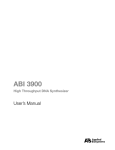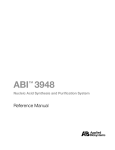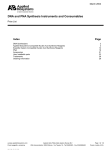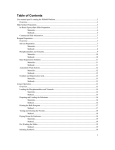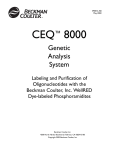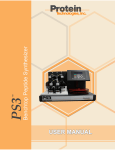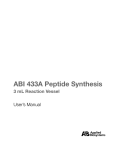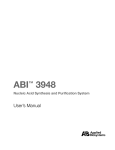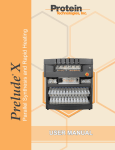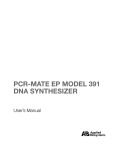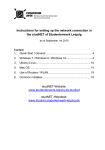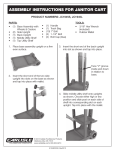Download User Bulletin - Thermo Fisher Scientific
Transcript
User Bulletin ABI 3948 Nucleic Acid Synthesis and Purification System 4 June 1998 (updated 06/2001) SUBJECT: General Maintenance of the Instrument Overview This user bulletin provides two routine maintenance procedures for the instrument, guidelines for using and managing reagents on the instrument, and a procedure for periodic cleaning of the jaw insert assemblies and replacing the jaw seals This document is a supplement to your instrument user’s manual and contains the following: Topic See Page Routine Maintenance Procedures 2 Reagent Management Issues 5 Periodic Cleaning and Seal Replacement 7 Routine Maintenance Procedures Maintenance This section provides two procedures to use for routine maintenance of the Procedures instrument, the Janitor procedure and the Ammonia Wash procedure. The Janitor procedure is executed in the Misc Procedures view in NPR version 2.00 Note and in the Edit Procedures view in version 2.20 of 3948Control software. The Ammonia Wash procedure is a standard part of version 2.00 software but must be imported into version 2.20 software. Janitor Procedure The Janitor procedure flushes all lines and valve blocks within the three chemistry process stations as follows: ♦ Flushes the Synthesis Workstation with acetonitrile, ♦ Flushes the Cleavage Workstation with water and acetonitrile, and ♦ Flushes the Purification Workstation with water and acetonitrile. Extensive and regular cleaning of the 3948 with this procedure helps to prevent blockages and reagent delivery failure. This procedure should be executed on a weekly basis. Note The instrument should be at the Ready state before this procedure is executed. To perform the Janitor procedure: Step 1 Place “empty” cartridges (OneStep™) on the instrument in positions 1 though 9. 2 Choose the Janitor procedure: 3 Page 2 of 13 Action ♦ From the Misc Procedures menu in version 2.00 software ♦ From the Edit Procedures view in version 2.20 software Click the Execute button to initiate the procedure. User Bulletin: ABI 3948 Nucleic Acid Synthesis and Purification System Ammonia Wash The Ammonia Wash procedure removes residual salts that deposit within the lines Procedure and valve blocks of the Synthesis Workstation. The salts can build up to the point where they either restrict reagent flow or particles can break loose from the inside of the tubing to cause blockages or damage to valve blocks. Ammonia dissolves these salts and prevents the build up. Note Be sure the instrument is at the Ready state before executing this procedure. To perform the Ammonia Wash procedure: Step 1 Action Perform the Janitor procedure before this procedure to remove any residual TCA. CAUTION Any residual TCA in a valve block would react with the ammonia and form a precipitate. Empty cartridges (OneStep™ Columns) should still be present on the instrument in positions 1 through 9 from previously performing the Janitor Procedure 2 For version 2.20 of 3948Control software, go to the Misc view and use the Import Procedure command (File menu) to import the Ammonia Wash procedure (supplied as an auxiliary on the version 2.2 Software Installation Disk (P/N 604530). 3 Choose the Ammonia Wash procedure in the Misc Procedure view. 4 Click the Execute button to initiate the procedure. Ammonia is sent through Valve Blocks A and B through the jaws and out to waste through Valve Block D, as shown in the figure below. User Bulletin: ABI 3948 Nucleic Acid Synthesis and Purification System Page 3 of 13 CAUTION This procedure should be executed only once a month. Excessive use of this procedure can result in damage to valve blocks A, B and D, as they are not designed to withstand prolonged or repeated exposure to ammonia. Page 4 of 13 User Bulletin: ABI 3948 Nucleic Acid Synthesis and Purification System Reagent Management Issues Introduction The process of oligonucleotide production is especially dependent upon the quality of the reagents that are placed on the instrument. This section provides guidelines and precautions for use of reagents on the ABI™ 3848 Nucleic Acid Synthesis and Purification System. Guidelines Follow the recommendations in the following table to avoid problems using reagents: ! WARNING ! Wear Chemical Resistant Gloves and Eye Protection while changing reagent bottles. Table 1. List of Reagent Management Issues Reagent/ Component Amidites and Tetrazole Guidelines ♦ Dilute nucleoside phosphoramidites in acetonitrile containing less than 100 ppm water. Any water introduced into these amidites will dramatically impair Note the efficiency of the coupling reaction. – Use 3948 automated dilution procedures where possible. – If performing manual dilution, use the guide provided for this procedure in Chapter 4 of the ABI™ 3948 User’s Manual (P/N 4303760). During manual dilution, take extreme care to avoid the ingress Note of atmospheric moisture. Amidite bottles should never be ‘topped-off’ as this may result in a gradual increase in the water content. Water ♦ Do not “top off” tetrazole bottles as this reagent is especially sensitive to water content. ♦ Change water after every run to avoid unwanted algal or bacterial growth that can result in blockages inside the instrument. Pure water is important since the 3948 instrument uses water Note as the wash solvent for the cleavage and purification systems. Ammonia ♦ Ammonia used on the 3948 should be 30% aqueous and should be replaced after 2 weeks on the instrument. Higher concentrations of ammonia are NOT recommended as they may increase fragmentation of the ammonia slug travelling to the deprotection heater. Fragmentation occurs because concentrated aqueous ammonia has a tendency to generate bubbles of vapor. The bubbles increase the resistance to flow of the ammonia in small diameter tubing and may cause the optical sensor at the deprotection coil to miss the “front-end” of the slug, lowering the measured yield of oligo. ♦ Store ammonia at 4 °C for a maximum of 1 month after opening. ♦ Change the bottle attached to the instrument containing the ammonia on a monthly basis to prevent weakening of its structure. User Bulletin: ABI 3948 Nucleic Acid Synthesis and Purification System Page 5 of 13 Table 1. List of Reagent Management Issues (continued) Reagent/ Component Guidelines Vent Line ♦ Monitor the vent line for any sign of a build-up of liquid in the line. Liquid in this line results from incorrect positioning. The line should not contain any “dips” and should start upward to the venting area so that any condensed vapor falls back into the waste container. Note Blockages in this line may result in reagent delivery failures. Waste Container ♦ Do not allow the waste container to overfill (more than three quarters full), as this may impair delivery of reagents through the valve blocks because of back-pressure from the waste container. Process Station and Jaw Assembly Areas ♦ Keep the process station and its assemblies (Synthesis, Cleavage, and Purification Workstations) free from dust as much as possible by weekly cleaning. Cleaning should be done by soft cloth or blowing with a compressed air container/spray can. The jaw seals must be kept free from dust to ensure efficient Note sealing against the OneStep™ columns. See the cleaning procedures under “Periodic Cleaning and Seal Replacement” on page 7. Argon Tank ♦ Monitor the pressure of Argon regularly to ensure that the pressure in the tank is always above 300 psi. CAUTION Do NOT attempt to change the argon bottle during synthesis as this may cause the PRC unit to ‘lock-up’. This causes the run to terminate and results in loss of the entire oligo set. ♦ Keep the input pressure to the instrument in the range of 13 to 17 psi (recommended pressure is 15 psi). The input pressure can be viewed in the Monitor Instrument View. ♦ Detect bottle leaks by listening for clicking from the PRC. Periodic clicking during instrument use is a normal feature, clicks at regular intervals when the instrument is in the Ready state may indicate a leaking bottle or cap assembly. Failure to act on bottle leaks may result in reagent delivery failures or excessive use of Argon. Leaks at bottle cap assemblies may be caused by: – chipped bottle necks, – split bottle seals, or – leaking cap assemblies or inserts. Replacement of any and all of the above may eliminate leaks. If the leak persists, call your local Field Service Engineer. A persistent leak at the tetrazole bottle position may cause crystallization of this reagent and result in blocked lines or valve blocks. Page 6 of 13 User Bulletin: ABI 3948 Nucleic Acid Synthesis and Purification System Periodic Cleaning and Seal Replacement Introduction This section provides a procedure for periodic cleaning of portions of the 3948 Process Station, shown below. The procedure provides instructions for cleaning the jaw insert assemblies and jaw gaskets or seals, and for replacing jaw seals if necessary. Jaw Insert Jaw Insert Assembly Assembly Shoulder Screws Besides periodically cleaning and replacing jaw gasket seals as described in this Note section, all 3948 OneStep™ Columns should be visually inspected for nicks on the upper sealing surface prior to installation on the instrument. Upper Sealing Surface User Bulletin: ABI 3948 Nucleic Acid Synthesis and Purification System Page 7 of 13 Background Most Crucial Components The jaws and their seals are one of the most crucial components in a ABI™ 3948 DNA Synthesis and Purification System. They provide the liquid tight seal against the OneStep™ columns. Failure to achieve sealing can result in spillage of liquid reagents onto the turntable assembly and/or reagent delivery failures. Integrity of Jaw Seals The transfer of the oligo dissolved in ammonia from the Cleavage Columns to the Deprotection Heater Coils (Xfer Clv Col) is also intimately associated with the seal of the OneStep™ column with the cleavage jaws. Failure to achieve a tight seal in this portion of the cycle results in fragmentation (introduction of air bubbles) of the slug of ammonia while traveling through the OneStep™ column on the way to the Deprotection heater assembly. The sensors at the top of the Deprotection Coils then have a difficult task in assessing where the front-end of the ammonia slug is and some ammonia (including oligo) may be sent out to waste, thus lowering overall oligo yields. IMPORTANT once a month. It is a good laboratory practice to perform periodic cleaning approximately Jaw Insert Assembly Periodically clean the jaw insert assemblies and jaw seals as described in the and Jaw Seals procedure in this section, referring to the figure below for a view of a jaw assembly Procedure before it is disassembled and to the figure on page 9 for an exploded view of a jaw insert assembly. Replace defective jaw seals as described in the procedure. H-lifter piece Page 8 of 13 User Bulletin: ABI 3948 Nucleic Acid Synthesis and Purification System ! WARNING ! Wear Chemical Resistant Gloves and Eye Protection while performing this procedure. To periodically clean jaw insert assemblies and jaw seals: Step 1 Action Prepare the instrument for cleaning as follows: a. Remove the instrument back panel. b. Lift the shoulder screws (see upper figure on page 7 for location) and gently slide back the process station. CAUTION Check and protect the ribbon cables and lines from snagging during this procedure. 2 Clean dust and chemical spills from the top and bottom of the turntable. The plate can be cleaned with a soft lint-free cloth or laboratory tissue soaked in a small amount of methanol. 3 Remove the Jaw Assemblies one at a time for cleaning while observing the precautions listed on the next page: a. Remove the first Jaw Assembly by pushing against the spring and twist. b. Pull the jaw out gently once the Insert is loose being careful not to stretch or crease the tubing attached to it. H-lifter Jaw Assembly D User Bulletin: ABI 3948 Nucleic Acid Synthesis and Purification System Page 9 of 13 To periodically clean jaw insert assemblies and jaw seals: (continued) Step Action 3 cont. CAUTION Do not remove all three Upper or Lower Jaw Insert Assemblies of any of the Workstations (Synthesis, Cleavage, or Purification) simultaneously, as this will cause the H-lifter piece (see figure on previous page for location) to drop out of position. CAUTION Do not stretch, crush, or crease the tubing attached to any of the jaws as this may cause restrictions in the flow of reagents through the jaws. c. 4 Pull the jaw out gently once the Insert is loose being careful not to stretch or crease the tubing attached to it. Clean the Jaw Assembly and Housing and inspect the jaw seal for possible replacement as follows: a. Wipe the Jaw Assembly and the Housing with a soft cloth or laboratory tissue soaked in methanol and remove any chemical deposits. b. Clean the seal with a cotton-tipped swab and methanol, inspecting the seal for aging or damage. Replace the seal if necessary (Upper Jaw Seal P/N 004726, Lower Jaw Seal P/N 004727). CAUTION Use of a hard or sharp metal object such as tweezers to pry the seal out will scratch the teflon insert and cause leaks. Use a soft plastic tip, e.g., a tie wrap or plastic pipette tip. Page 10 of 13 5 Inspect the tubing in the middle of the Jaw Seal Assembly for clogs or particles. Blow or gently tap to clear the line. 6 Put the Assembly back in its housing by pressing down and turning the jaw assembly until it clicks in place. 7 Repeat steps 4 through 8 for each of the upper jaw assemblies. 8 Pull the turntable assembly to its maximum extension to aid in removal of the lower Jaw Assemblies, and repeat steps 4 through 8 for each of the lower Jaw Assemblies. 9 Restore the instrument to operating condition by sliding the turntable assembly back into position and replacing the instrument back and left side panels. 10 Perform leak test procedure to verify that the hardware has been correctly returned to the correct position. User Bulletin: ABI 3948 Nucleic Acid Synthesis and Purification System © Copyright 2001, Applied Biosystems This product is for research purposes only. ABI PRISM and Applied Biosystems are registered trademarks of Applera Corporation or its subsidiaries in the U.S. and certain other countries. ABI is a trademark of Applera Corporation or its subsidiaries in the U.S. and certain other countries. P/N 4305180 Rev. B; Stock Number 239853-002













